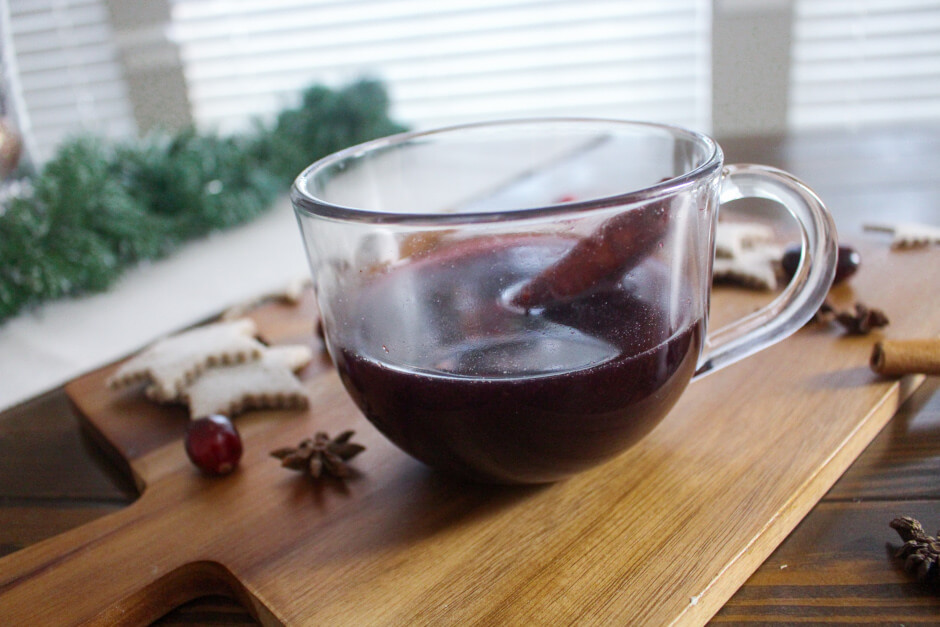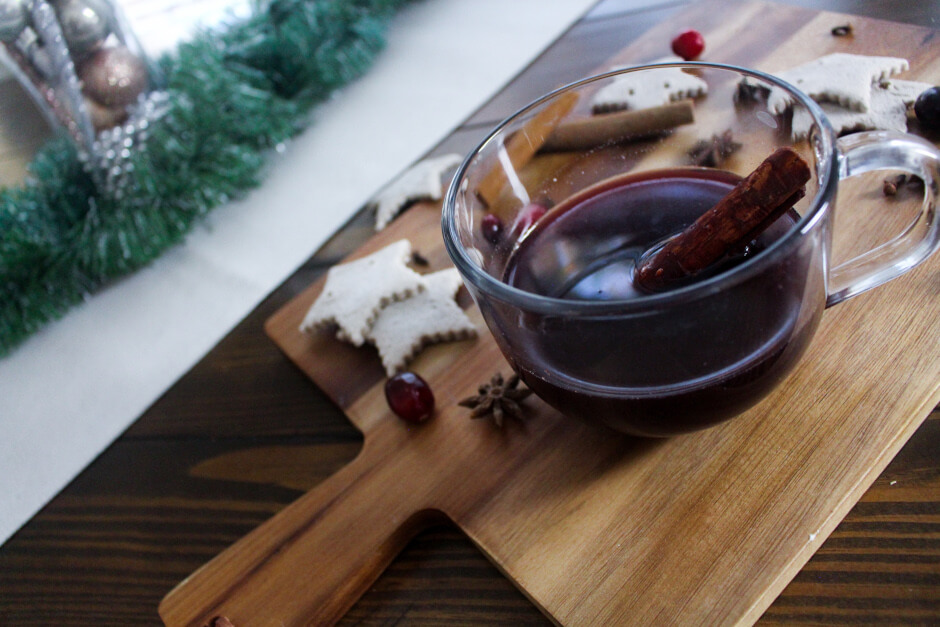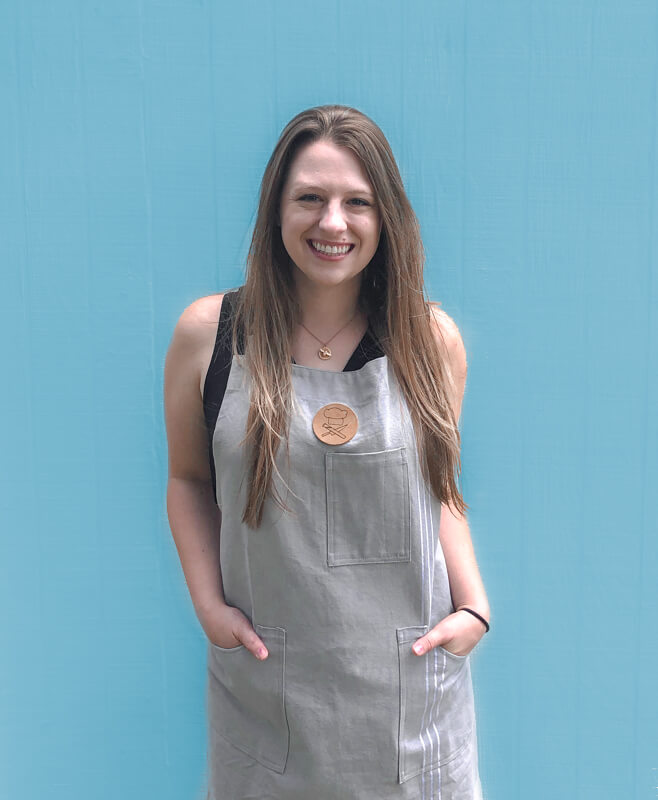Laura the Gastronaut > Recipes > Cocktails >
Mulled WineMulled Wine
Cooking Laboratory
December 11, 2020 | Updated: December 12, 2022 | Laura
*This post may contain affiliate sales links. Please see full disclosure policy for details.
Nothing is more comforting than a nice warm cup of delicious homemade mulled wine on a winter day. After researching and testing multiple recipes, I developed my own mulled wine recipe that's backed by history and science. This warm winter drink is perfect for all Christmas festivities during the holiday season!

Warm deliciously spiced goodness.
Mulled wine is a Christmas tradition that dates way back. In fact, people have been drinking mulled wine since the 2nd century. You will find people sipping on mulled wine at Christmas markets and holiday gatherings around the world, and it is especially prevalent at a German Christmas Market. In Germany, mulled wine is known as glühwein which means 'glow wine'.
Once I took my first sip of the warm spiced wine, I understood why! It's comforting. It's delicious. It's cozy, and it smells just like Christmas. It was a no brainer for me to make mulled wine my 4th episode of the Cooking Laboratory.
I get to talk alcohol science and drink multiple batches of mulled wine. It's a win-win!
Mulled wine is usually made with a cheap dry red wine. It's warmed up with various spices and citrusy fruits until it takes on the perfect flavor of Christmas time.
My husband and I have made the tradition of drinking mulled wine while putting up our Christmas decorations every year. It's such a fun tradition. After a couple glasses of the wine, I always tear up looking at our festive humble abode while "Have Yourself a Merry Little Christmas" plays in the background.
Is there anything better than to be snuggled up on the couch, a fire roaring in the fireplace, the smell of spices in the air, Kenny G playing Christmas music, Home Alone playing on the TV, and a full glass of mulled wine while looking at all those beautiful twinkling lights? Yeah, I didn't think so.
How did I come up with this recipe?
Well, I looked into the history of mulled wine, learned about mulled wine science, and made four different recipes that I found online. I then took what I learned in my lab (AKA: my kitchen), and through trial & error came up with this wonderful mulled wine that's backed by history and science.
Let’s talk about the other four recipes that I chose to make!
First, I made Culinary Hills's Mulled Wine (Culinary Hill Homepage). The ingredient that made this recipe different was the addition of extra orange juice outside of the oranges. Coming from somebody who is relatively new to drinking mulled wine, this recipe seemed like it was more traditional. It had great flavor.
Second, I made Tasty's Mulled Wine (Tasty Homepage). This recipe definitely stood out from the others because of its addition of pineapple juice. It tasted almost like a wine punch so not really traditional but still good.
Third, I made Ina Gartens's Mulled Wine (Food Network Homepage). Of course, I had to try Ina's mulled wine recipe. This recipe is set apart from the others in that it calls for apple cider as well. Ina uses honey instead of sugar to sweeten the wine which is what they did way back in the day when they first started drinking mulled wine!
Lastly, I made The Forked Spoon's Spicy Mulled Wine (The Forked Spoon Homepage). Okay, my husband and I may be a little biased towards this mulled wine recipe. I didn't realize it when I picked it, but this is actually the recipe we have been using to make mulled wine previously. It hit me when I was making it! With that said, this is a wonderful mulled wine recipe. I love the addition of fresh cranberries and blackberries. Also, the brandy makes it an extra special treat!
Overall, all of these recipes were delicious. I would happily drink any of them again. My husband picked The Forked Spoon's mulled wine as his favorite. Though, as mentioned previously, this decision may be a little biased. It just tastes like Christmas to us!
My Mulled Wine Recipe

✽ Honey
I used honey instead of sugar for two reasons. One, this is the sweetener they used way way back in the day so I love the idea of keeping the recipe traditional in this aspect. Second, I love honey.
✽ Citrus Fruits & Peels
I liked the taste of just adding the lemon peel instead of adding lemon juice. As for the orange, I throw in the peel and the fruit juices for maximum orange flavor!
✽ Spices
I grind and grate whole spices in order to get a huge spice flavor. By grinding and grating, we will increase the surface area of the mulled wine spices so more spice is exposed to the wine.
✽ Star Anise
Star anise is very sweet and has a licorice flavoring to it. I added it towards the end to finish the mulled wine off with a slight sweetness but not to overdo it by having the star anise in there the whole time.
✽ Warming Up the Wine
It's so important not to let your mulled wine boil. If it does boil, you will be boiling off your alcohol, and nobody wants that! I heat the mulled wine up in two separate steps to prevent the alcohol from disappearing.
First, I heat up a small amount of wine, the honey, and the spices. This will allow the oils from the spices to be extracted and the honey to meld with the wine. After this step, the rest of the wine and the brandy is added. It is all heated just until it is warm.
A great resource I used to help with the science behind the mulled wine was from Laura Powell. You can read the article here and watch the video here.

Mulled Wine (German Glühwein)
By Laura | Laura the Gastronaut
Prep Time: 5 minutes | Cook Time: 15 minutes | Total Time: 20 minutes
Yield: 4 servings
__________________________________
Mulled wine is a traditional Christmas beverage made with red wine, spices, and citrusy fruits that is guaranteed to make you feel warm and cozy. This hot spiced wine is a perfect way to celebrate the holidays on a cold winter day. So, whip up a batch, start a fire, turn on those holiday tunes, grab your blanket, and enjoy.
*Some of these ingredient links may be affiliate links. As an Amazon Associate I earn from qualifying purchases.*
Ingredients
• 1/2 cup honey
• 1 (750 mL) bottle dry red wine, such as Cabernet Sauvignon, Merlot, or Pinot Noir
• 1 entire peel from lemon
• 1 orange, peeled and juiced
• 4 whole cloves, crushed
• 2 cinnamon sticks
• 1/2 whole nutmeg, grated
• 2 fresh ginger slices, 1" long
• 1/2 cup fresh cranberries, halved
• Pinch of black pepper
• 1/2 cup brandy
• 2 star anise
Instructions
➊ In a large pot, pour in honey and just enough wine just to cover the honey. Stir in lemon peel, orange peel, juice from orange, crushed cloves, cinnamon sticks, grated nutmeg, ginger slices, cranberries, and black pepper.
➋ Place the pot over medium heat and allow to simmer for about 5 minutes.
➌ After simmering, pour in the rest of the red wine, brandy, and star anise.
➍ Heat up the wine over medium heat just until warm, about 174°F (79°C). Do not let boil.
➎ Strain the mulled wine into glasses and enjoy! You can garnish with cinnamon sticks, orange slices, lemon slices, or fresh cranberries, if desired.
Notes
✽ Wine Choice: I always go with a cheap dry red wine. We will be adding in honey, so a dry is the best wine so the sweetness does not overpower. I go with a cheap bottle of wine because the spices will mask a lot of the wine flavor. Using an expensive wine will not likely increase the taste your mulled wine.
✽ Cloves: If you absolutely have no way of crushing your cloves, putting them in whole will not be the end of the world. Just know that their flavor will not be as strong. You may be able to crush them some with the back of a spoon.
✽ Brandy: I love the addition to brandy to this mulled wine. However, you can leave it out. Or you can replace with another liquor of your choice.
✽ Warming the Wine: It's so important not to let your wine boil. Watch it closely so you can take it off the heat once warmed. You could also use a thermometer and take it off the heat once it reaches 174°F (79°C).
✽ Slow Cooker Mulled Wine: Adding the mulled wine to a slow cooker allows you to enjoy sipping on this wine all day without having to worry about keeping it warm. After step 2, you can transfer the contents to a slow cooker. Add the rest of the red wine, brandy, and star anise, and heat mulled wine on low heat until warm. Keep mulled wine on the low heat setting until it is gone!
✽ How Long Does Mulled Wine Last? & How to Store Mulled Wine: Store any leftover mulled wine in an airtight container in the fridge for up to 3 days. Heat up in a pot on the stove over medium heat.
__________________________________
✽ Did you make this recipe?
Let me know by leaving a comment below and sharing on Instagram. Tag @laurathegastronaut and hashtag it #laurathegastronaut.
Category: Cocktails, Winter Cuisine: German
Keywords: winter cocktails, christmas cocktails, german christmas wine, german mulled wine, easy glühwein recipe, homemade mulled wine, hot german wine
More Winter Recipes:
✽ Pomegranate Cranberry Mocktail (this non-alcoholic drink is filled with so much tasty Christmas flavor)
✽ Cinnamon Jello Shots (these cinnamon flavored jello shots are sure to be a hit at your next Christmas party)
✽ Spiced Old Fashioned (a spin on the classic Old Fashioned with spices added in for extra flavor)
→ Check out all of my Christmas recipes!
Bon appétit!
December 11, 2020 by Laura Ehlers
*This Mulled Wine blog post and recipe may contain some Amazon affiliate links. These link to products that I personally use and recommend. If you purchase anything using my links, it will not cost you anything. It will though give laurathegastronaut.com some financial support which helps me keep this blog running. Thank you for reading my blogs and your continued support.







